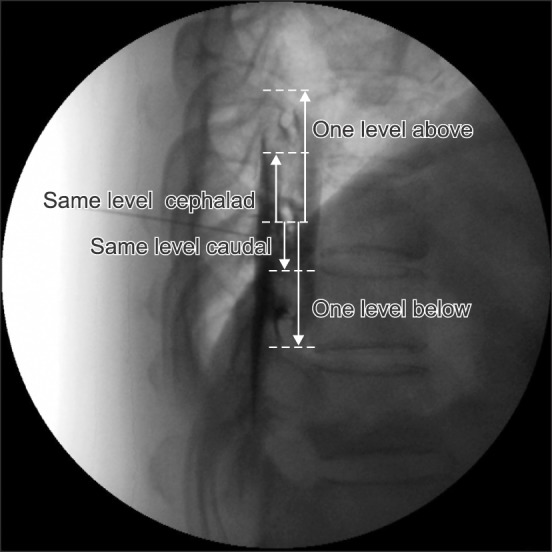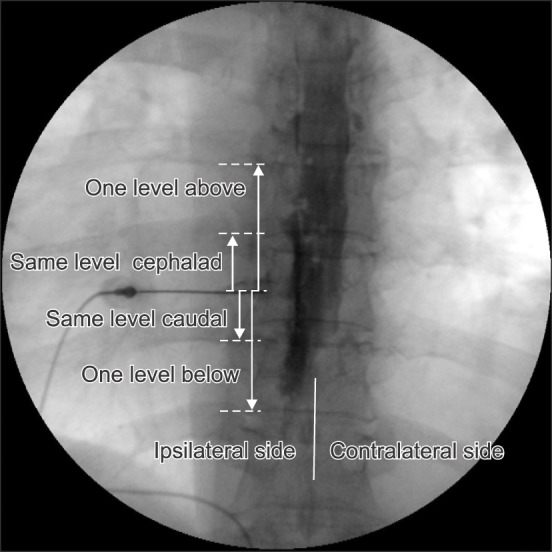Korean J Pain.
2018 Apr;31(2):125-131. 10.3344/kjp.2018.31.2.125.
Preliminary study on contrast flow analysis of thoracic transforaminal epidural block
- Affiliations
-
- 1Department of Anesthesiology and Pain Medicine, Dongsan Medical Center, School of Medicine, Keimyung University, Daegu, Korea. Parkkibum@dsmc.or.kr
- KMID: 2410835
- DOI: http://doi.org/10.3344/kjp.2018.31.2.125
Abstract
- BACKGROUND
The thoracic transforaminal epidural block (TTFEB) is usually performed to treat herpes zoster or postherpetic neuralgia (PHN). Especially, multiple segmental involvements and approximate contrast medium spread range, according to volume, help to choose the proper drug volume in the transforaminal epidural block. This study investigated the contrast medium spread patterns of 1-ml to 3-ml TTFEBs.
METHODS
A total of 26 patients with herpes zoster or PHN were enrolled in this study. All participants received 1 ml, 2 ml, or 3 ml of contrast medium. Results were divided into Groups A, B and C based on the volume (1, 2, or 3 ml), with n = 26 for each group. After the injection of contrast medium, the spread levels were estimated in both the lateral and anteroposterior (AP) images using fluoroscopy.
RESULTS
The cephalad spread of contrast medium in the lateral image as expressed by the median (interquartile range) was 2.00 levels (1.00-2.00) for Group A, 2.50 (2.00-3.00) for Group B, and 3.00 (2.00-4.00) for Group C. The caudal spread level of contrast medium was 1.00 (1.00-2.00) for Group A, 2.00 (2.00-3.00) for Group B, and 2.00 (2.00-3.00) for Group C. There was ventral and dorsal spread of the 3-ml contrast medium injection in 88% (23/26) of cases in the lateral image.
CONCLUSIONS
Injection of 3 ml of contrast medium through the foramina spread 6 levels in a cephalocaudal direction. Spread patterns revealed a cephalad preference. TTFEB resulted in dorsal and ventral spread in a high percentage of cases. This procedure may be useful for transferring drugs to the dorsal and ventral roots.
Keyword
MeSH Terms
Figure
Reference
-
1. Furman MB, Mehta AR, Kim RE, Simon JI, Patel R, Lee TS, et al. Injectate volumes needed to reach specific landmarks in lumbar transforaminal epidural injections. PM R. 2010; 2:625–635. PMID: 20659718.
Article2. Gnann JW Jr, Whitley RJ. Clinical practice. Herpes zoster. N Engl J Med. 2002; 347:340–346. PMID: 12151472.3. Lee SE, Joe HB, Park JH, Yi IK, Choi YH, Han KR, et al. Distribution range of cervical interlaminar epidural injections: a comparative study with 2.5 ml, 5 ml, and 10 ml of contrast. Pain Physician. 2013; 16:155–164. PMID: 23511682.4. Wagner AL, Murtagh FR. Selective nerve root blocks. Tech Vasc Interv Radiol. 2002; 5:194–200. PMID: 12599170.
Article5. Hong J, Jung SW. Fluoroscopically guided thoracic interlaminar epidural injection: a comparative epidurography study using 2.5 ml and 5 ml of contrast dye. Pain Physician. 2016; 19:E1013–E1018. PMID: 27676671.6. Yokoyama M, Hanazaki M, Fujii H, Mizobuchi S, Nakatsuka H, Takahashi T, et al. Correlation between the distribution of contrast medium and the extent of blockade during epidural anesthesia. Anesthesiology. 2004; 100:1504–1510. PMID: 15166571.
Article7. Kim YC, Lim YJ, Lee SC. Spreading pattern of epidurally administered contrast medium in rabbits. Acta Anaesthesiol Scand. 1998; 42:1092–1095. PMID: 9809094.
Article8. Visser WA, Liem TH, van Egmond J, Gielen MJ. Extension of sensory blockade after thoracic epidural administration of a test dose of lidocaine at three different levels. Anesth Analg. 1998; 86:332–335. PMID: 9459244.
Article9. Okutomi T, Hashiba MM, Hashiba S, Masubuchi A, Morishima HO. The effects of single and fractionated doses of mepivacaine on the extent of thoracic epidural block. Reg Anesth Pain Med. 2001; 26:450–455. PMID: 11561266.
Article10. Furman MB, Lee TS, Mehta A, Simon JI, Cano WG. Contrast flow selectivity during transforaminal lumbosacral epidural steroid injections. Pain Physician. 2008; 11:855–861. PMID: 19057631.11. Kim SY, Han KR, Kim C. An analysis of the contrast patterns of lumbar transforaminal epidural injection. Korean J Pain. 2008; 21:217–223.
Article12. Cramer GD, Darby SA. Clinical anatomy of the spine, spinal cord, and ANS. 3rd ed. St. Louis (MO): Elsevier Mosby;2014. p. 218–222.13. McLeod GA, Cumming C. Thoracic epidural anaesthesia and analgesia. Contin Educ Anaesth Crit Care Pain. 2004; 4:16–19.
Article14. Igarashi T, Hirabayashi Y, Shimizu R, Saitoh K, Fukuda H, Mitsuhata H. The lumbar extradural structure changes with increasing age. Br J Anaesth. 1997; 78:149–152. PMID: 9068330.
Article15. Hirabayashi Y, Shimizu R, Matsuda I, Inoue S. Effect of extradural compliance and resistance on spread of extradural analgesia. Br J Anaesth. 1990; 65:508–513. PMID: 2248818.
Article16. Goel A, Pollan JJ. Contrast flow characteristics in the cervical epidural space: an analysis of cervical epidurograms. Spine (Phila Pa 1976). 2006; 31:1576–1579. PMID: 16778691.17. Weil L, Frauwirth NH, Amirdelfan K, Grant D, Rosenberg JA. Fluoroscopic analysis of lumbar epidural contrast spread after lumbar interlaminar injection. Arch Phys Med Rehabil. 2008; 89:413–416. PMID: 18295616.
Article18. Hanakawa T, Hashimoto S, Kawamura J, Nakamura M, Suenaga T, Matsuo M. Magnetic resonance imaging in a patient with segmental zoster paresis. Neurology. 1997; 49:631–632. PMID: 9270616.
Article19. Baron R, Wasner G. Prevention and treatment of postherpetic neuralgia. Lancet. 2006; 367:186–188. PMID: 16427472.
Article20. Purcell-Jones G, Pither CE, Justins DM. Paravertebral somatic nerve block: a clinical, radiographic, and computed tomographic study in chronic pain patients. Anesth Analg. 1989; 68:32–39. PMID: 2910135.21. Richardson J, Jones J, Atkinson R. The effect of thoracic paravertebral blockade on intercostal somatosensory evoked potentials. Anesth Analg. 1998; 87:373–376. PMID: 9706933.
Article22. Ji G, Niu J, Shi Y, Hou L, Lu Y, Xiong L. The effectiveness of repetitive paravertebral injections with local anesthetics and steroids for the prevention of postherpetic neuralgia in patients with acute herpes zoster. Anesth Analg. 2009; 109:1651–1655. PMID: 19713253.
Article23. Glaser SE, Falco F. Paraplegia following a thoracolumbar transforaminal epidural steroid injection. Pain Physician. 2005; 8:309–314. PMID: 16850088.
- Full Text Links
- Actions
-
Cited
- CITED
-
- Close
- Share
- Similar articles
-
- Pulsatile subdural contrast image during attempted lumbar transforaminal epidural block: A case report
- An Analysis of Pattern of Transforaminal Epidurography
- Comparison of the Effects between Interlaminar Epidural Block and Transforaminal Epidural Block under C-arm Guide in Lumbar Disc Herniated Radiculopathy
- Evaluation of Contrast Flow Patterns with Fluoroscopic Guided Lumbar Transforaminal Epidural Injections
- Acute Cervical Subdural Hematoma with Quadriparesis after Cervical Transforaminal Epidural Block



